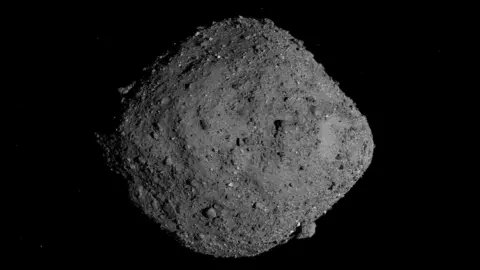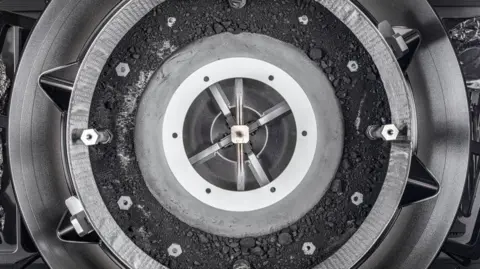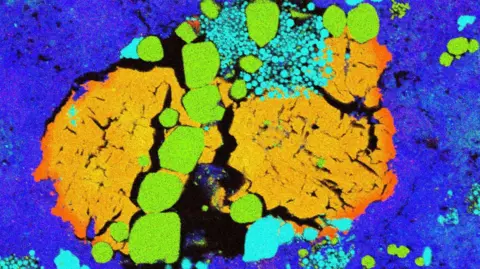Senior Science Journalist
 NASA/Goddard/College of Arizona
NASA/Goddard/College of ArizonaThe chemical constructing blocks of life have been discovered within the grainy mud of an asteroid referred to as Bennu, an evaluation reveals.
Samples of the house rock, which had been scooped up by a Nasa spacecraft and delivered to Earth, include a wealthy array of minerals and 1000’s of natural compounds.
These embrace amino acids, that are the molecules that make up proteins, in addition to nucleobases – the elemental parts of DNA.
This does not imply there was ever life on Bennu, however it helps the speculation that asteroids delivered these very important components to Earth once they crashed into our planet billions of years in the past.
Scientists assume those self same compounds might even have been delivered to different worlds in our Photo voltaic System.
“What we have realized from it’s wonderful,” stated Prof Sara Russell, a cosmic mineralogist from the Pure Historical past Museum in London.
“It is telling us about our personal origins, and it permits us to reply these actually, actually huge questions on the place life started. And who does not need to find out about how life began?”
The findings are revealed in two papers within the journal Nature.
 NASA/Erika Blumenfeld/Joseph Aebersold
NASA/Erika Blumenfeld/Joseph AebersoldGrabbing a little bit of Bennu has been some of the audacious missions Nasa has ever tried.
A spacecraft referred to as Osiris Rex unfurled a robotic arm to gather among the 500m-wide house rock, earlier than packing it right into a capsule and returning it to Earth in 2023.
About 120g of black mud was collected and shared with scientists world wide. This won’t sound like a lot materials, however it’s proved to be a treasure trove.
“Each grain is telling us one thing new about Bennu,” stated Prof Russell, who’s been learning the tiny specks.
A couple of teaspoonful of the asteroid was despatched to scientists within the UK.
 Pure Historical past Museum/Tobias Salge
Pure Historical past Museum/Tobias SalgeThe brand new analysis has proven that the house rock is packed filled with nitrogen and carbon-rich compounds.
These embrace 14 of the 20 amino acids that life on Earth makes use of to construct proteins and all 4 of the ring-shaped molecules that make up DNA – adenine, guanine, cytosine and thymine.
The examine has additionally discovered an array of minerals and salts, suggesting water was as soon as current on the asteroid. Ammonia, which is essential for biochemical reactions, was found within the pattern too.
A few of these compounds have been seen in house rocks which have fallen to Earth, however others have not been detected till now.
“It is simply unimaginable how wealthy it’s. It is full of those minerals that we have not seen earlier than in meteorites and the mix of them that we have not seen earlier than. It has been such an thrilling factor to review,” stated Prof Russell.
This newest examine provides to rising proof that asteroids introduced water and natural materials to Earth.
“The early Photo voltaic System was actually turbulent and there have been tens of millions of asteroids like Bennu flying about,” defined Dr Ashley King, from the Pure Historical past Museum.
The thought is that these bombarded the younger Earth, seeding our planet with components that gave us the oceans and made life attainable.
However Earth wasn’t the one world getting hit by house rocks. Asteroids would have been colliding with different planets too.
“Earth is exclusive, in that it is the solely place the place we now have discovered life thus far, however we all know asteroids had been delivering these components, the carbon and the water, all through the Photo voltaic System,” stated Dr King.
“And one of many huge issues that we’re making an attempt to grasp now’s, you probably have the best situations, why do we now have life right here on Earth – and will we probably discover it elsewhere in our Photo voltaic System?”
It is a key query that scientists will proceed to attempt to reply.
They’ve many years of analysis forward on the mud introduced again from Bennu, and elements of our cosmic neighbourhood nonetheless to discover.

